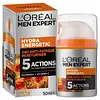What's inside
What's inside
 Key Ingredients
Key Ingredients

 Benefits
Benefits

 Concerns
Concerns

 Ingredients Side-by-side
Ingredients Side-by-side

Water
Skin ConditioningGlycerin
HumectantAlcohol Denat.
AntimicrobialIsohexadecane
EmollientHydrogenated Polyisobutene
EmollientAmmonium Polyacryloyldimethyl Taurate
Emulsion StabilisingMentha Piperita Extract
CleansingPEG/PPG-18/18 Dimethicone
EmulsifyingHdi/Trimethylol Hexyllactone Crosspolymer
Dimethicone
EmollientCetearyl Ethylhexanoate
EmollientCaffeine
Skin ConditioningSodium Citrate
BufferingSodium Hydroxide
BufferingSilica
AbrasiveLaminaria Digitata Extract
Skin ProtectingPaullinia Cupana Seed Extract
Skin ConditioningMagnesium PCA
HumectantAscorbyl Glucoside
AntioxidantIsopropyl Myristate
EmollientPropylene Glycol
HumectantCaprylyl Glycol
EmollientMenthol
MaskingPentylene Glycol
Skin ConditioningPolymethyl Methacrylate
Tocopherol
AntioxidantPhenoxyethanol
PreservativeCI 19140
Cosmetic ColorantCI 42090
Cosmetic ColorantLinalool
PerfumingLimonene
PerfumingParfum
MaskingWater, Glycerin, Alcohol Denat., Isohexadecane, Hydrogenated Polyisobutene, Ammonium Polyacryloyldimethyl Taurate, Mentha Piperita Extract, PEG/PPG-18/18 Dimethicone, Hdi/Trimethylol Hexyllactone Crosspolymer, Dimethicone, Cetearyl Ethylhexanoate, Caffeine, Sodium Citrate, Sodium Hydroxide, Silica, Laminaria Digitata Extract, Paullinia Cupana Seed Extract, Magnesium PCA, Ascorbyl Glucoside, Isopropyl Myristate, Propylene Glycol, Caprylyl Glycol, Menthol, Pentylene Glycol, Polymethyl Methacrylate, Tocopherol, Phenoxyethanol, CI 19140, CI 42090, Linalool, Limonene, Parfum
Water
Skin ConditioningGlycerin
HumectantGlyceryl Stearate Se
EmulsifyingCetearyl Alcohol
EmollientCaprylic/Capric Triglyceride
MaskingCocos Nucifera Oil
MaskingStearic Acid
CleansingPhenoxyethanol
PreservativeBenzyl Alcohol
PerfumingCarbomer
Emulsion StabilisingSodium Hydroxide
BufferingNiacinamide
SmoothingPanthenol
Skin ConditioningSodium Ascorbyl Phosphate
AntioxidantSodium Hyaluronate
HumectantTocopheryl Acetate
AntioxidantEthylhexylglycerin
Skin ConditioningDehydroacetic Acid
PreservativeLecithin
EmollientTrisodium Ethylenediamine Disuccinate
Ascorbyl Palmitate
AntioxidantTocopherol
AntioxidantHelianthus Annuus Seed Oil
EmollientWater, Glycerin, Glyceryl Stearate Se, Cetearyl Alcohol, Caprylic/Capric Triglyceride, Cocos Nucifera Oil, Stearic Acid, Phenoxyethanol, Benzyl Alcohol, Carbomer, Sodium Hydroxide, Niacinamide, Panthenol, Sodium Ascorbyl Phosphate, Sodium Hyaluronate, Tocopheryl Acetate, Ethylhexylglycerin, Dehydroacetic Acid, Lecithin, Trisodium Ethylenediamine Disuccinate, Ascorbyl Palmitate, Tocopherol, Helianthus Annuus Seed Oil
 Reviews
Reviews

Ingredients Explained
These ingredients are found in both products.
Ingredients higher up in an ingredient list are typically present in a larger amount.
Glycerin is already naturally found in your skin. It helps moisturize and protect your skin.
A study from 2016 found glycerin to be more effective as a humectant than AHAs and hyaluronic acid.
As a humectant, it helps the skin stay hydrated by pulling moisture to your skin. The low molecular weight of glycerin allows it to pull moisture into the deeper layers of your skin.
Hydrated skin improves your skin barrier; Your skin barrier helps protect against irritants and bacteria.
Glycerin has also been found to have antimicrobial and antiviral properties. Due to these properties, glycerin is often used in wound and burn treatments.
In cosmetics, glycerin is usually derived from plants such as soybean or palm. However, it can also be sourced from animals, such as tallow or animal fat.
This ingredient is organic, colorless, odorless, and non-toxic.
Glycerin is the name for this ingredient in American English. British English uses Glycerol/Glycerine.
Learn more about GlycerinPhenoxyethanol is a preservative that has germicide, antimicrobial, and aromatic properties. Studies show that phenoxyethanol can prevent microbial growth. By itself, it has a scent that is similar to that of a rose.
It's often used in formulations along with Caprylyl Glycol to preserve the shelf life of products.
Sodium Hydroxide is also known as lye or caustic soda. It is used to adjust the pH of products; many ingredients require a specific pH to be effective.
In small amounts, sodium hydroxide is considered safe to use. However, large amounts may cause chemical burns due to its high alkaline.
Your skin has a natural pH and acid mantle. This acid mantle helps prevent harmful bacteria from breaking through. The acid mantle also helps keep your skin hydrated.
"Alkaline" refers to a high pH level. A low pH level would be considered acidic.
Learn more about Sodium HydroxideTocopherol (also known as Vitamin E) is a common antioxidant used to help protect the skin from free-radicals and strengthen the skin barrier. It's also fat soluble - this means our skin is great at absorbing it.
Vitamin E also helps keep your natural skin lipids healthy. Your lipid skin barrier naturally consists of lipids, ceramides, and fatty acids. Vitamin E offers extra protection for your skin’s lipid barrier, keeping your skin healthy and nourished.
Another benefit is a bit of UV protection. Vitamin E helps reduce the damage caused by UVB rays. (It should not replace your sunscreen). Combining it with Vitamin C can decrease sunburned cells and hyperpigmentation after UV exposure.
You might have noticed Vitamin E + C often paired together. This is because it is great at stabilizing Vitamin C. Using the two together helps increase the effectiveness of both ingredients.
There are often claims that Vitamin E can reduce/prevent scarring, but these claims haven't been confirmed by scientific research.
Learn more about TocopherolWater. It's the most common cosmetic ingredient of all. You'll usually see it at the top of ingredient lists, meaning that it makes up the largest part of the product.
So why is it so popular? Water most often acts as a solvent - this means that it helps dissolve other ingredients into the formulation.
You'll also recognize water as that liquid we all need to stay alive. If you see this, drink a glass of water. Stay hydrated!
Learn more about Water